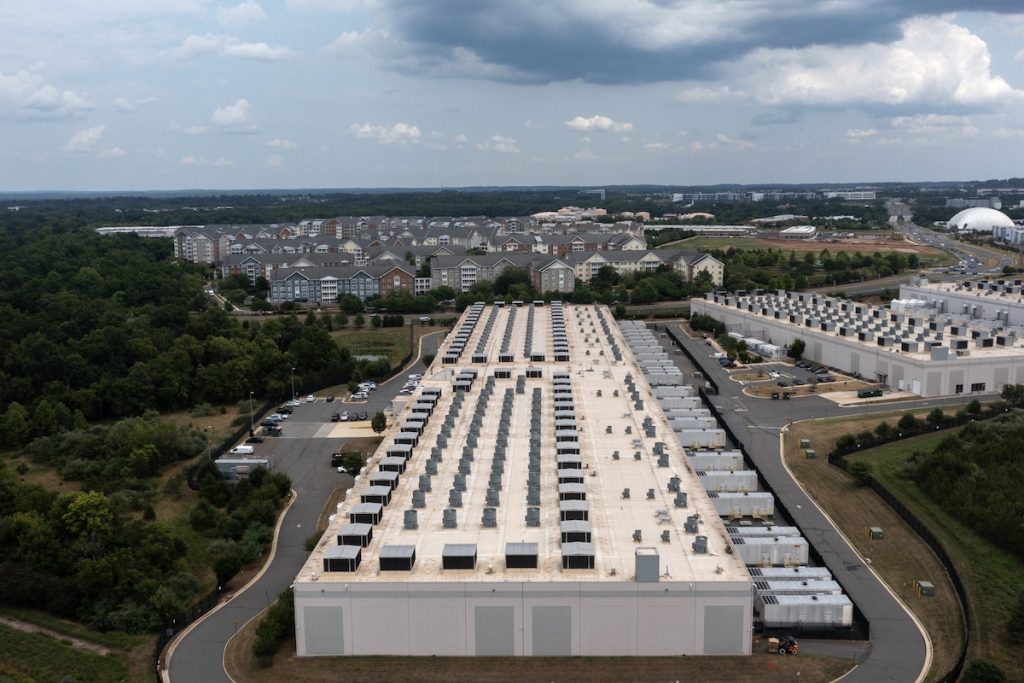Amazon and Google Look to Small Nuclear Reactors for Surge in AI and Data Centers
4 min read
The IAD71 Amazon Web Services data center in Ashburn, Virginia on July 17, 2024. Nathan Howard / Getty Images
Founded in 2005 as an Ohio-based environmental newspaper, EcoWatch is a digital platform dedicated to publishing quality, science-based content on environmental issues, causes, and solutions.
Amazon on Wednesday said it will invest in small nuclear reactors (SNRs), two days after Google made a similar announcement.
Both companies are seeking carbon-free sources of electricity to meet increasing demand from artificial intelligence (AI) and data centers.
The new plans follow last month’s announcement by Microsoft that it plans to purchase power for its data centers from the shuttered Three Mile Island nuclear power plant in Pennsylvania, reported The Associated Press.
All three tech giants have been investing in wind and solar, but say they need more clean energy to meet emissions reduction commitments and surging demand.
Amazon said it had signed three agreements for the development of SMRs, Reuters reported. The company said it would provide funding for a feasibility study for an SMR project by X-Energy in Washington State.
Amazon will be able to purchase power from four modules under the agreement.
Energy Northwest will have the option of adding as many as eight 80 megawatt (MW) modules, for a total capacity potential of 960 MW — enough to power over 770,000 homes. The extra energy would be made available to Amazon, as well as utilities to power businesses and residences.
“Our agreements will encourage the construction of new nuclear technologies that will generate energy for decades to come,” said CEO of Amazon Web Services Matt Garman, as reported by Reuters.
Currently, no SMRs have been constructed, but their components will be built in a factory in order to keep construction costs down, unlike larger reactors, which are built onsite.
The smaller nuclear reactors have been criticized for being too costly to achieve economies of scale.
According to the International Energy Agency, the total electricity consumption of data centers could reach in excess of 1,000 terawatt (TW) hours by 2026 — more than twice the power used in 2022, The Associated Press reported.
“AI is driving a significant increase in the amount of data centers and power that are required on the grid,” Kevin Miller, vice president of global data centers for Amazon Web Services, told The Associated Press.
“We view advanced new nuclear capacity as really key and essential,” Miller added.
United States Secretary of Energy Jennifer Granholm expressed her approval that Amazon was bringing its own electricity to the new data centers.
The United States has set a target of reaching 100 percent clean energy by 2035.
Granholm said SMRs represent a “huge piece of how we’re going to solve this puzzle.”
SMRs can generate approximately a third of the electricity of a traditional nuclear reactor. Developers say they can be built more quickly and at lower cost, while being scaled to fit the needs of a particular site. The plan is to have these smaller reactors begin producing power by early next decade, provided they are approved by the Nuclear Regulatory Commission and the technology is successful.
Without new sources of clean power being added to the grid as more data centers spring up, the U.S. is at risk of “browning the grid,” said Kathryn Huff, former U.S. nuclear energy assistant secretary and current associate professor in the Department of Nuclear, Plasma, and Radiological Engineering at the University of Illinois Urbana-Champaign. Either that or including more non-green energy sources.
The Biden-Harris administration views nuclear power as crucial to its greenhouse gas emissions reduction goals, reported The New York Times. Nuclear energy currently provides roughly 20 percent of the country’s electricity.
“Revitalizing America’s nuclear sector is key to adding more carbon-free energy to the grid and meeting the needs of our growing economy — from A.I. and data centers to manufacturing and health care,” Granholm said, as The New York Times reported.
Subscribe to get exclusive updates in our daily newsletter!
By signing up, you agree to the Terms of Use and Privacy Policy & to receive electronic communications from EcoWatch Media Group, which may include marketing promotions, advertisements and sponsored content.





